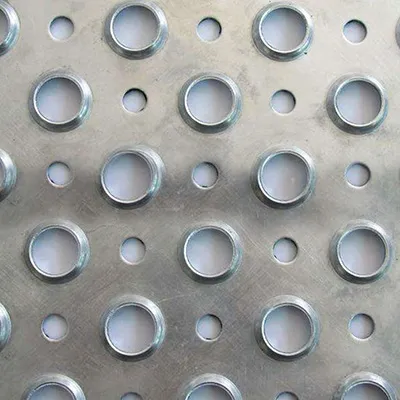-
+86 15030157877
-
sales@galvanizedmetalmesh.com
Nov . 29, 2024 14:12 Back to list
Premium Perforated Sheets for Superior Quality and Versatile Applications
Understanding High-Quality Perforated Sheets Applications, Benefits, and Manufacturing
Perforated sheets have become an essential component across various industries, from construction and architecture to automotive and food processing. Among these, high-quality perforated sheets stand out due to their superior durability, precision in hole patterns, and wide range of applications. This article explores the significance of high-quality perforated sheets, the manufacturing processes involved, and their numerous applications.
What is a Perforated Sheet?
A perforated sheet is a type of material that features a series of holes or openings created through perforation. The process typically involves using a punch and die system to create uniform holes in sheets of metal, plastic, or other materials. The size, shape, and arrangement of these holes can vary greatly, depending on the intended function of the sheet.
Manufacturing High-Quality Perforated Sheets
To achieve high quality, the manufacturing process of perforated sheets is crucial. It commonly involves the following steps
1. Material Selection The choice of raw material significantly impacts the quality of the final product. Common materials include stainless steel, aluminum, and carbon steel, each offering different levels of strength, corrosion resistance, and aesthetic appeal.
2. Design and Engineering Before the perforation process begins, engineers design the hole pattern according to the specific application requirements. This involves calculations regarding hole size, spacing, and arrangement, ensuring optimal performance.
3. Perforation Process Using a punch press, holes are punched through the sheet material. High-quality perforation technology allows for precise and repeatable hole shapes, whether they are round, square, or custom shapes.
4. Finishing After perforation, the sheets undergo finishing processes such as deburring and surface treatment to enhance their aesthetic appeal and durability. Finishing treatments such as galvanizing, powder coating, or anodizing can improve corrosion resistance and longevity.
5. Quality Control Finally, a rigorous quality control process checks for dimensional accuracy, surface finish, and overall aesthetic quality. This step is crucial in ensuring that the perforated sheets meet industry standards and client specifications.
Applications of High-Quality Perforated Sheets
High-quality perforated sheets find applications in a plethora of industries
high quality perforated sheet

1. Architecture and Design In modern architecture, perforated sheets are often used as decorative facades or interior panels, providing both aesthetic value and functional benefits such as light filtration and privacy.
2. Automotive Industry In vehicle manufacturing, perforated sheets are utilized for components like grilles, air intake systems, and sound-dampening panels. Their lightweight nature and strength make them ideal for improving fuel efficiency while maintaining structural integrity.
3. Filtration Systems In water treatment and HVAC systems, high-quality perforated sheets act as filters, allowing the passage of liquids or air while trapping unwanted particles. Their precision perforations ensure optimal filtration performance.
4. Sound Control Perforated sheets are also employed in soundproofing applications. By strategically arranging the holes, they can absorb sound waves, making them an effective solution for acoustic panels in recording studios, auditoriums, and public spaces.
5. Furniture Design In furniture manufacturing, perforated sheets add a contemporary touch. They are often used in shelving, tables, and partitions, combining aesthetic beauty with practical functionality.
Benefits of High-Quality Perforated Sheets
Investing in high-quality perforated sheets brings multifaceted benefits
- Durability High-quality materials and manufacturing processes ensure that perforated sheets withstand the rigors of their intended environments, leading to lower maintenance costs.
- Customization Manufacturers can create custom designs tailored to specific applications, enhancing versatility.
- Aesthetic Appeal The visual designs achievable with perforated sheets can elevate the look of any space or product, engaging customers and enhancing brand image.
- Efficiency Whether used for filtration, ventilation, or aesthetic purposes, perforated sheets contribute to the overall efficiency of systems across various applications.
Conclusion
High-quality perforated sheets are more than just functional materials; they embody the intersection of engineering, design, and innovation. Their robust nature and diverse applications underscore their importance in modern manufacturing and design, making them invaluable assets across numerous industries. As technology advances, we can expect further enhancements in materials and manufacturing methods, broadening the potential of perforated sheets even more.
-
Artificial Grass Fence: Privacy, Beauty & Low Maintenance
NewsAug.08,2025
-
Premium Perforated Metal Mesh & Custom Sheets
NewsAug.07,2025
-
Premium Security Window Screen Mesh | Unmatched Safety
NewsAug.05,2025
-
Premium Artificial Grass Fence | AI Design Privacy Solution
NewsAug.04,2025
-
Premium Hexagonal Gabion Mesh Solutions | Durable & Eco-Friendly
NewsAug.03,2025
-
Welded Gabion Solutions: Durable & AI-Enhanced Designs
NewsAug.01,2025



